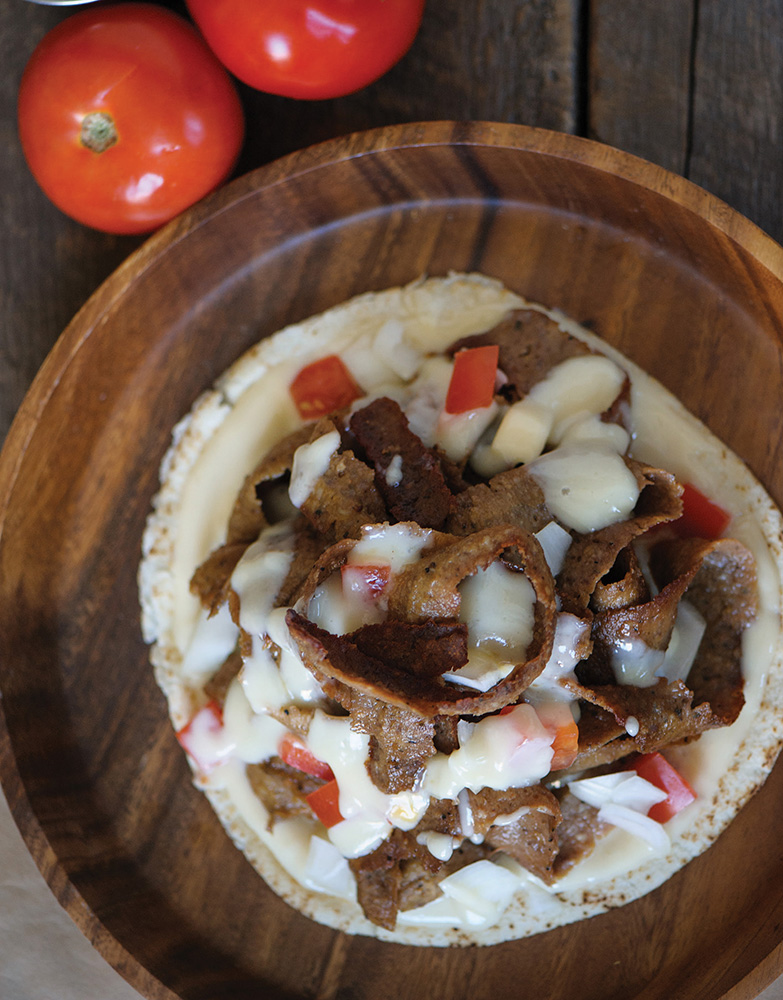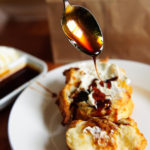The Halifax Donair
Quintessential Halifax street food, the donair has connections to many Old World dishes called doner kebabs. Roasted lamb, pork, and beef on a skewer garnished with pickles and a tangy or spicy sauce, then wrapped in a flatbread — this classic has been served for hundreds of years by many world cultures. It’s also the only Nova Scotian food that signals a specific city (Halifax), similar to other iconic foods such as the Philly cheese-steak sandwich (Philadelphia), smoked meat sandwiches and poutine (Montreal), beaver tails (Ottawa) or clam chowder (Boston). The sauce makes the donair, and that’s why the Halifax version is cherished. You either love ’em or hate ’em. I adore ’em. I’ve created this recipe to mimic the spit roasting and carving of the meat you find in a donair shop. It’s easy to make and tastes exactly like a donair you’d wolf down at 2 a.m. to finish a night on the town. Grab yourself a big handful of napkins and tuck in!

In a stand mixer fitted with dough hook, combine beef, bread crumbs, water, oil, garlic powder, onion powder, pepper, oregano, bouillon powder, cayenne pepper, and salt. On low speed, process until liquid has incorporated, then slowly increase speed to knead donair mixture until pasty and sticking to sides, at least 10 minutes.
Layer two 24-inch/60 cm lengths of foil on work surface; lightly grease top with food-release spray or canola oil. With hands, evenly divide donair mixture into 4 piles, side by side, lengthwise along the centre of foil; shape into a log about 14 -to 16-inches (35 to 40 cm) long. Tightly roll foil around the log, compressing donair mixture; tightly twist foil at each end to seal. Transfer to a rimmed baking sheet; bake at 325°F (160°C) oven until internal-read thermometer in centre of log registers 160°F (71°C), about 90 minutes. Immediately transfer to a deep baking dish, surround with ice and refrigerate for at least 4 hours, preferably overnight.
Preheat oven to broil; slide top rack into the top slot. Holding roll upright on cutting board, remove foil from donair; with a very sharp knife, slice long ribbons of meat down the cylinder and transfer in a loose pile to the rimmed baking sheet. Broil for 1 minute; remove from oven and, with tongs, toss. Return to oven and broil for 1 minute. In the same manner, toss and broil until donair mixture is browned and heated through about 4 times. Fill a large bowl with cold water; set aside. In a large non-stick skillet over medium heat, warm small amount of canola oil; one at a time, quickly dip pitas into the water, immediately transfer to a pan and cook until edges are beginning to brown, about 30 seconds per side.
Place each warm pita on a plate (or foil square for takeout-style); top with heaping 1 tbsp (15 mL) Classic Donair Sauce and sprinkle with tomatoes and onion. Evenly divide donair meat among pitas; top with 2 to 3 tbsp (30 to 45 mL) Classic Donair Sauce. If serving takeout-style, roll 2 opposite sides of pita over filling, then roll donair in foil, tucking in foil at one end but leaving other (top end) open.
Makes 6 donairs
Note: Although donair meat can be made by hand in a mixing bowl, it is much better to use a stand-up electric mixer and choose the dough-hook attachment to get the meat properly mixed. As the meat mixes, the proteins and fats emulsify and help to create the firm, chewy texture of the donair, a signature component of the dish. Without working the meat, the resulting texture will be more crumbly, similar to meatloaf or hamburger. Finally, carving the donair lengthwise once it has cooled and firmed up closely resembles how the meat is traditionally shaved off the spit roaster in a takeout donair shop.
In a bowl, stir together milk and sugar; evenly sprinkle with garlic powder and gently whisk until sugar has dissolved. Whisk in vinegar, scraping sides, until thickened. Transfer to airtight container and refrigerate for at least 2 hours, up to 12 hours, to thicken as it cools.
Makes 1 1⁄2 cups (375 mL)
Ingredients
Directions
In a stand mixer fitted with dough hook, combine beef, bread crumbs, water, oil, garlic powder, onion powder, pepper, oregano, bouillon powder, cayenne pepper, and salt. On low speed, process until liquid has incorporated, then slowly increase speed to knead donair mixture until pasty and sticking to sides, at least 10 minutes.
Layer two 24-inch/60 cm lengths of foil on work surface; lightly grease top with food-release spray or canola oil. With hands, evenly divide donair mixture into 4 piles, side by side, lengthwise along the centre of foil; shape into a log about 14 -to 16-inches (35 to 40 cm) long. Tightly roll foil around the log, compressing donair mixture; tightly twist foil at each end to seal. Transfer to a rimmed baking sheet; bake at 325°F (160°C) oven until internal-read thermometer in centre of log registers 160°F (71°C), about 90 minutes. Immediately transfer to a deep baking dish, surround with ice and refrigerate for at least 4 hours, preferably overnight.
Preheat oven to broil; slide top rack into the top slot. Holding roll upright on cutting board, remove foil from donair; with a very sharp knife, slice long ribbons of meat down the cylinder and transfer in a loose pile to the rimmed baking sheet. Broil for 1 minute; remove from oven and, with tongs, toss. Return to oven and broil for 1 minute. In the same manner, toss and broil until donair mixture is browned and heated through about 4 times. Fill a large bowl with cold water; set aside. In a large non-stick skillet over medium heat, warm small amount of canola oil; one at a time, quickly dip pitas into the water, immediately transfer to a pan and cook until edges are beginning to brown, about 30 seconds per side.
Place each warm pita on a plate (or foil square for takeout-style); top with heaping 1 tbsp (15 mL) Classic Donair Sauce and sprinkle with tomatoes and onion. Evenly divide donair meat among pitas; top with 2 to 3 tbsp (30 to 45 mL) Classic Donair Sauce. If serving takeout-style, roll 2 opposite sides of pita over filling, then roll donair in foil, tucking in foil at one end but leaving other (top end) open.
Makes 6 donairs
Note: Although donair meat can be made by hand in a mixing bowl, it is much better to use a stand-up electric mixer and choose the dough-hook attachment to get the meat properly mixed. As the meat mixes, the proteins and fats emulsify and help to create the firm, chewy texture of the donair, a signature component of the dish. Without working the meat, the resulting texture will be more crumbly, similar to meatloaf or hamburger. Finally, carving the donair lengthwise once it has cooled and firmed up closely resembles how the meat is traditionally shaved off the spit roaster in a takeout donair shop.
In a bowl, stir together milk and sugar; evenly sprinkle with garlic powder and gently whisk until sugar has dissolved. Whisk in vinegar, scraping sides, until thickened. Transfer to airtight container and refrigerate for at least 2 hours, up to 12 hours, to thicken as it cools.
Makes 1 1⁄2 cups (375 mL)





